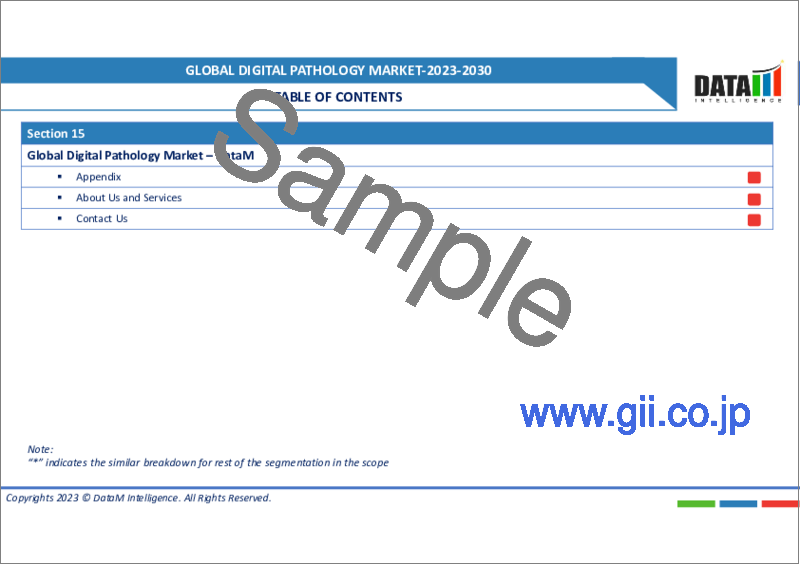|
|
市場調査レポート
商品コード
1319148
デジタル病理の世界市場-2023年~2030年Global Digital Pathology Market - 2023-2030 |
||||||
カスタマイズ可能
適宜更新あり
|
|||||||
| デジタル病理の世界市場-2023年~2030年 |
|
出版日: 2023年07月31日
発行: DataM Intelligence
ページ情報: 英文 195 Pages
納期: 即日から翌営業日
|
- 全表示
- 概要
- 目次
市場概要
世界のデジタル病理市場は、2022年に9億米ドルに達し、2030年には17億米ドルに達し、有利な成長が予測されています。世界のデジタル病理市場は、予測期間中(2023-2030年)にCAGR 8.7%を示すと予測されています。テレパソロジーや遠隔診察の採用が増加していることが、デジタル病理の市場動向を牽引しています。
デジタル病理市場は著しい成長と変貌を遂げています。デジタル病理は病理画像をデジタル化して管理するもので、病理医が電子的にスライドにアクセスして分析できるようにします。この技術は、ワークフロー効率の改善、共同作業の強化、正確な診断、自動解析のための人工知能(AI)アルゴリズムとの統合の可能性など、数多くの利点を提供します。
世界のデジタル病理市場は、慢性疾患の有病率の増加、人工知能(AI)の統合、ラボの効率性を高めるためのデジタル病理の採用の増加、デジタル病理システムの技術進歩、高齢者人口の増加、コンパニオン診断や医薬品開発におけるデジタル病理のアプリケーションの増加などの要因によって牽引されています。
市場力学
ラボの効率化を目的としたデジタル病理の採用増加がデジタル病理市場の成長を牽引
従来の病理検査では、物理的なスライドガラスを使用するため、手作業による取り扱い、保管、輸送が必要でした。このプロセスには時間がかかり、エラーも発生しやすいです。デジタル病理検査では物理的なスライドが不要になり、病理医が遠隔操作で画像にアクセスして分析できるようになります。これにより、ワークフローの効率が向上し、所要時間が短縮され、検査室全体の生産性が向上します。
デジタル病理は病理医間のシームレスなコラボレーションも促進します。地理的な場所に関係なく、画像の共有、遠隔診察、セカンドオピニオンを簡単に行うことができます。病理医はリアルタイムで協力できるため、より正確な診断と患者の予後改善につながります。さらに、デジタル病理は、自動分析のための人工知能(AI)と機械学習アルゴリズムの統合を可能にし、効率と精度をさらに高める。
例えば、2023年6月19日、アラブ首長国連邦(UAE)最大の病院の1つで、アブダビ・ヘルス・サービス・カンパニー(SEHA)とメイヨー・クリニックの合弁パートナーシップであるシェイク・シャフバウト・メディカル・シティ(SSMC)は、最先端の病理学研究所を開設しました。
コンパニオン診断と医薬品開発におけるアプリケーションの増加もデジタル病理市場の成長を促進する
コンパニオン診断では、特定の治療法に反応する可能性の高い患者を特定するために診断テストを使用します。デジタル病理は、組織サンプルとバイオマーカーの分析を可能にすることで、標的治療に対する患者の適格性を判断するコンパニオン診断において重要な役割を果たします。デジタル病理プラットフォームは、遺伝子変異やタンパク質発現などのバイオマーカーの正確で標準化された評価を提供します。
デジタル病理は、医薬品開発や研究にも大きく貢献しています。製薬会社や研究者は、潜在的な薬剤候補の組織サンプルへの影響を分析することができます。デジタル病理プラットフォームは、前臨床試験や臨床試験において、新薬の有効性と安全性を評価するための標準化された再現可能な方法を提供します。
画像解析を自動化し、AIアルゴリズムを活用することで、デジタル病理は薬物治療によって誘発される細胞や分子の変化の特定と定量化を支援します。これにより、医薬品開発プロセスが加速され、新治療法の有効性と安全性に関する情報に基づいた意思決定が支援されます。
例えば、2023年6月22日、高解像度の定量的デジタル病理と人工知能のリーダーであるPharmaNest Inc.は、デジタル病理の空間的に分解された定量的組織パネルの発売を発表し、線維化状態の文脈における組織傷害と炎症の重症度を記述し、発見モデルから臨床開発まで、あらゆる状態における線維化の文脈における炎症の新規AI主導の調査を可能にします。
限られた標準化が市場の成長を妨げます
デジタル病理はまだ発展途上であり、画像フォーマット、メタデータ、分析アルゴリズムなど様々な面で標準化が進んでいないです。標準化されたプロトコルやガイドラインがないため、異なるプラットフォームや施設間でのデータ共有、比較、再現性に課題が生じる可能性があります。このような課題を克服するためには、標準化への取り組みと利害関係者間の協力が必要です。
COVID-19の影響分析
COVID-19の大流行はデジタル病理市場に大きな影響を与えました。パンデミックにより社会的距離を置く必要が生じ、対面での交流が減少したため、遠隔診断とテレパソロジーが不可欠となっています。デジタル病理の導入により、病理医は病理画像に遠隔からアクセスして分析できるようになり、ウイルス感染のリスクを最小限に抑えながら診断サービスを継続できるようになっています。パンデミックの間、遠隔診察と遠隔病理学ソリューションの需要が急増し、デジタル病理システムの導入が促進されました。
ロシア・ウクライナ紛争の影響分析
ロシア・ウクライナ紛争は、世界のデジタル病理市場に中程度の影響を与えると推定されます。デジタル病理の分野における国際的な共同研究や研究イニシアチブは、紛争による混乱に直面する可能性があります。これにより、共同プロジェクトの進捗や知識・リソースの共有に影響が出る可能性があり、世界のデジタル病理市場における技術革新や進歩が鈍化する可能性があります。
目次
第1章 調査手法と調査範囲
第2章 定義と概要
第3章 エグゼクティブサマリー
第4章 市場力学
- 影響要因
- 促進要因
- ラボの効率性を高めるためのデジタル病理の採用の増加
- コンパニオン診断と医薬品開発におけるアプリケーションの増加
- 抑制要因
- デジタル病理システムの高コスト
- 機会
- デジタル病理システムの技術的進歩
- 影響分析
- 促進要因
第5章 産業分析
- ポーターの5フォース分析
- サプライチェーン分析
- 価格分析
- 規制分析
第6章 COVID-19分析
第7章 製品別
- ソフトウェア
- スキャナー
- ストレージシステム
- 通信システム
- その他
第8章 アプリケーション別
- 創薬
- 遠隔相談
- 診断
- トレーニングと教育
- その他
第9章 タイプ別
- 人体病理
- 獣医病理
第10章 技術別
- ホールスライドイメージング
- テレパソロジー
- 静的テレパソロジー
- 動的テレパソロジー
第11章 エンドユーザー別
- 病院
- 製薬・バイオテクノロジー企業
- 受託研究機関
- 研究・学術機関
- その他
第12章 地域別
- 北米
- 米国
- カナダ
- メキシコ
- 欧州
- ドイツ
- 英国
- フランス
- スペイン
- イタリア
- その他欧州
- 南米
- ブラジル
- アルゼンチン
- その他南米
- アジア太平洋
- 中国
- インド
- 日本
- オーストラリア
- その他アジア太平洋地域
- 中東・アフリカ
第13章 競合情勢
- 競合シナリオ
- 市況/シェア分析
- M&A分析
第14章 企業プロファイル
- F. Hoffmann-La Roche Ltd.
- 会社概要
- 製品ポートフォリオと説明
- 財務概要
- 主な発展
- Koninklijke Philips N.V.
- Olympus Corporation
- Leica Biosystems Nussloch GmbH(Danaher Corporation)
- Hamamatsu Photonics, Inc.
- Mikroscan Technologies Inc.
- Inspirata, Inc.(Fujifilm)
- Visiopharm A/S
- Huron Technologies International Inc.
- ContextVision AB
第15章 付録
Market Overview
The global digital pathology market reached US$ 0.9 billion in 2022 and is projected to witness lucrative growth by reaching up to US$ 1.7 billion by 2030. The global digital pathology market is expected to exhibit a CAGR of 8.7% during the forecast period (2023-2030). The increasing adoption of telepathology and remote consultation is driving up demand for digital pathology market trends.
The digital pathology market is experiencing significant growth and transformation. Digital pathology involves the digitization and management of pathology images, enabling pathologists to access and analyze slides electronically. This technology offers numerous advantages, including improved workflow efficiency, enhanced collaboration, accurate diagnosis, and potential integration with artificial intelligence (AI) algorithms for automated analysis.
The global digital pathology market is driven by the factors such as the increasing prevalence of chronic diseases, integration of artificial intelligence(AI), increasing adoption of digital pathology to enhance lab efficiency, technological advancements in digital pathology systems, the rising geriatric population, and increasing applications of digital pathology in companion diagnostics and drug development.
Market Dynamics
Increasing Adoption of Digital Pathology to Enhance Lab Efficiency Drives the Growth of the Digital Pathology Market
Traditional pathology practices involve the use of physical glass slides that require manual handling, storage, and transportation. This process can be time-consuming and prone to errors. Digital pathology eliminates the need for physical slides and enables pathologists to access and analyze images remotely. This enhances workflow efficiency, reduces turnaround times, and improves the overall productivity of the laboratory.
Digital pathology also facilitates seamless collaboration among pathologists. It allows for easy sharing of images, remote consultations, and second opinions, regardless of geographical location. Pathologists can collaborate in real time, leading to more accurate diagnoses and improved patient outcomes. Moreover, digital pathology enables the integration of artificial intelligence (AI) and machine learning algorithms for automated analysis, further enhancing efficiency and accuracy.
For instance, on June 19, 2023, Sheikh Shakhbout Medical City (SSMC), one of the UAE's largest hospitals and a joint-venture partnership between Abu Dhabi Health Services Company (SEHA) and Mayo Clinic, launched its state-of-the-art, Pathology Laboratory, which will support SSMC's expert-led pathology team in diagnosing disease and complex conditions with the utmost accuracy using AI-powered tools and applications.
Increasing Applications in Companion Diagnostics and Drug Development Also Drive the Growth of the Digital Pathology Market
Companion diagnostics involves using diagnostic tests to identify patients who are likely to respond to a specific therapeutic treatment. Digital pathology plays a crucial role in companion diagnostics by enabling the analysis of tissue samples and biomarkers to determine a patient's eligibility for targeted therapies. Digital pathology platforms provide an accurate and standardized assessment of biomarkers such as genetic mutations or protein expression, which are essential for guiding treatment decisions.
Digital pathology is also making significant contributions to drug development and research. It allows pharmaceutical companies and researchers to analyze the effects of potential drug candidates on tissue samples. Digital pathology platforms offer a standardized and reproducible method for assessing the efficacy and safety of new drugs during preclinical and clinical trials.
By automating image analysis and leveraging AI algorithms, digital pathology assists in identifying and quantifying cellular and molecular changes induced by drug treatments. This accelerates the drug development process and aids in making informed decisions regarding the efficacy and safety of new therapies.
For instance, on June 22, 2023, PharmaNest Inc, a leader in high-resolution quantitative Digital Pathology and Artificial Intelligence, announced the launch of its Digital Pathology spatially resolved, quantitative tissue panels to describe the severity of tissue injury and inflammation in the context of fibrotic conditions and allow novel AI-driven investigations of inflammation in the context of fibrosis for any condition, from discovery models to clinical development.
Limited Standardization will Hamper the Growth of the Market.
Digital pathology is still evolving, and there is a lack of standardization in various aspects, including image formats, metadata, and analytical algorithms. The absence of standardized protocols and guidelines can create challenges in data sharing, comparison, and reproducibility across different platforms and institutions. Efforts towards standardization and collaboration among stakeholders are necessary to overcome these challenges.
COVID-19 Impact Analysis
The COVID-19 pandemic significantly impacted the digital pathology market. The pandemic necessitated social distancing measures and reduced in-person interactions, making remote diagnosis and telepathology essential. Digital pathology enabled pathologists to remotely access and analyze pathology images, allowing for continued diagnostic services while minimizing the risk of virus transmission. The demand for remote consultation and telepathology solutions surged during the pandemic, driving the adoption of digital pathology systems.
Russia-Ukraine War Impact Analysis
The Russia-Ukraine conflict is estimated to have a moderate impact on the global digital pathology market. International collaborations and research initiatives in the field of digital pathology could face disruptions due to the conflict. This may affect the progress of joint projects and the sharing of knowledge and resources, potentially slowing down innovation and advancements in the global digital pathology market.
Segment Analysis
The global digital pathology market is segmented based on product, application, type, technology, end-user, and region.
Software from the Product Segment Accounts for 37.9% of the Digital Pathology Market Share
Digital pathology software offers advanced image analysis tools that assist pathologists in quantifying and analyzing tissue samples. These tools can automate certain tasks, such as cell counting, measuring biomarker expression, and identifying specific cellular structures. This enhances the efficiency and accuracy of diagnosis, reducing the reliance on manual analysis.
Software platforms in digital pathology increasingly integrate AI capabilities for automated analysis and pattern recognition. AI algorithms can assist in identifying anomalies, predicting disease outcomes, and providing decision support to pathologists. This integration enhances efficiency, accuracy, and consistency in diagnosis and allows for the discovery of new biomarkers and therapeutic targets.
Digital pathology software provides robust data management and storage capabilities. It enables the creation of centralized repositories for pathology images, patient data, and associated metadata. These repositories serve as valuable resources for research, quality assurance, and educational purposes. Software solutions ensure secure storage, retrieval, and sharing of digital pathology data while adhering to data protection regulations.
For instance, on June 8, 2023, Indica Labs announced the launch of a service offering deployment and ongoing support of its HALO digital pathology software in a fully managed cloud-hosted environment powered by Amazon Web Services (AWS). The service enables organizations to benefit from Indica Labs' software development and cloud deployment expertise while maintaining full ownership and control over their AWS account. Indica Labs' entire suite of HALO software, including the HALO Image Analysis platform, HALO AI deep learning classifier add-on, HALO Link browser-based image management system, and HALO AP anatomic pathology workflow platform, can now be deployed in professionally managed AWS cloud-hosted environments.
Geographical Analysis
North America Accounted for Approximately 39.8% of the Market Share in 2022, Owing to the Advanced Healthcare Infrastructure and Presence of Major Players
North America boasts a well-developed and advanced healthcare infrastructure, including hospitals, diagnostic laboratories, and research institutions. The region has made significant investments in healthcare technologies, including digital pathology, to enhance patient care and diagnostic capabilities. The availability of state-of-the-art facilities and resources facilitates the adoption and implementation of digital pathology systems.
North America is home to several major players in the digital pathology market, including technology providers, software developers, and research organizations. These companies have made substantial investments in research and development, driving technological advancements and innovation in the field. The presence of established players with strong market positions contributes to the overall market growth and dominance of North America.
For instance, in September 2022, INFINITT North America, an award-winning developer of enterprise imaging solutions for healthcare, announced a collaboration with Hamamatsu Corporation to jointly promote Hamamatsu whole slide scanners (NanoZoomers) and INFINITT Digital Pathology Solution (IDPS) to its United States customers.
Competitive Landscape
The major global players in the digital pathology market include: F. Hoffmann-La Roche Ltd., Koninklijke Philips N.V., Olympus Corporation, Leica Biosystems Nussloch GmbH (Danaher Corporation), Hamamatsu Photonics, Inc., Mikroscan Technologies, Inc., Inspirata, Inc. (Fujifilm), Visiopharm A/S, Huron Technologies International Inc., and ContextVision AB.
Why Purchase the Report?
- To visualize the global digital pathology market segmentation based on product, application, type, technology, end-user, and region, as well as understand key commercial assets and players.
- Identify commercial opportunities by analyzing trends and co-development.
- Excel data sheet with numerous data points of digital pathology market-level with all segments.
- PDF report consists of a comprehensive analysis after exhaustive qualitative interviews and an in-depth study.
- Product mapping available as Excel consisting of key products of all the major players.
The global digital pathology market report would provide approximately 53 tables, 54 figures, and 195 Pages.
Target Audience 2023
- Manufacturers/ Buyers
- Industry Investors/Investment Bankers
- Research Professionals
- Emerging Companies
Table of Contents
1. Methodology and Scope
- 1.1. Research Methodology
- 1.2. Research Objective and Scope of the Report
2. Definition and Overview
3. Executive Summary
- 3.1. Snippet by Product
- 3.2. Snippet by Application
- 3.3. Snippet by Type
- 3.4. Snippet by Technology
- 3.5. Snippet by End-User
- 3.6. Snippet by Region
4. Dynamics
- 4.1. Impacting Factors
- 4.1.1. Drivers
- 4.1.1.1. Increasing Adoption of Digital Pathology to Enhance Lab Efficiency
- 4.1.1.2. Increasing Applications in Companion Diagnostics and Drug Developments
- 4.1.2. Restraints
- 4.1.2.1. High Cost of Digital Pathology Systems
- 4.1.3. Opportunity
- 4.1.3.1. Technological Advancements in Digital Pathology Systems
- 4.1.4. Impact Analysis
- 4.1.1. Drivers
5. Industry Analysis
- 5.1. Porter's 5 Force Analysis
- 5.2. Supply Chain Analysis
- 5.3. Pricing Analysis
- 5.4. Regulatory Analysis
6. COVID-19 Analysis
- 6.1. Analysis of COVID-19
- 6.1.1. Scenario Before COVID-19
- 6.1.2. Scenario During COVID-19
- 6.1.3. Scenario Post COVID-19
- 6.2. Pricing Dynamics Amid COVID-19
- 6.3. Demand-Supply Spectrum
- 6.4. Government Initiatives Related to the Market During the Pandemic
- 6.5. Manufacturer's Strategic Initiatives
- 6.6. Conclusion
7. By Product
- 7.1. Introduction
- 7.1.1. Market Size Analysis and Y-o-Y Growth Analysis (%), By Product
- 7.1.2. Market Attractiveness Index, By Product
- 7.2. Software *
- 7.2.1. Introduction
- 7.2.2. Market Size Analysis and Y-o-Y Growth Analysis (%)
- 7.3. Scanners
- 7.4. Storage Systems
- 7.5. Communication Systems
- 7.6. Others
8. By Application
- 8.1. Introduction
- 8.1.1. Market Size Analysis and Y-o-Y Growth Analysis (%), By Application
- 8.1.2. Market Attractiveness Index, By Application
- 8.2. Drug Discovery *
- 8.2.1. Introduction
- 8.2.2. Market Size Analysis and Y-o-Y Growth Analysis (%)
- 8.3. Teleconsultation
- 8.4. Diagnosis
- 8.5. Training & Education
- 8.6. Others
9. By Type
- 9.1. Introduction
- 9.1.1. Market Size Analysis and Y-o-Y Growth Analysis (%), By Type
- 9.1.2. Market Attractiveness Index, By Type
- 9.2. Human Pathology *
- 9.2.1. Introduction
- 9.2.2. Market Size Analysis and Y-o-Y Growth Analysis (%)
- 9.3. Veterinary Pathology
10. By Technology
- 10.1. Introduction
- 10.1.1. Market Size Analysis and Y-o-Y Growth Analysis (%), By Technology
- 10.1.2. Market Attractiveness Index, By Technology
- 10.2. Whole Slide Imaging *
- 10.2.1. Introduction
- 10.2.2. Market Size Analysis and Y-o-Y Growth Analysis (%)
- 10.3. Telepathology
- 10.3.1. Static Telepathology
- 10.3.2. Dynamic Telepathology
11. By End-User
- 11.1. Introduction
- 11.1.1. Market Size Analysis and Y-o-Y Growth Analysis (%), By End-User
- 11.1.2. Market Attractiveness Index, By End-User
- 11.2. Hospital Laboratories *
- 11.2.1. Introduction
- 11.2.2. Market Size Analysis and Y-o-Y Growth Analysis (%)
- 11.3. Pharmaceutical And Biotechnology Companies
- 11.4. Contract Research Organizations
- 11.5. Research & Academic Institutes
- 11.6. Others
12. By Region
- 12.1. Introduction
- 12.1.1. Market Size Analysis and Y-o-Y Growth Analysis (%), By Region
- 12.1.2. Market Attractiveness Index, By Region
- 12.2. North America
- 12.2.1. Introduction
- 12.2.2. Key Region-Specific Dynamics
- 12.2.3. Market Size Analysis and Y-o-Y Growth Analysis (%), By Product
- 12.2.4. Market Size Analysis and Y-o-Y Growth Analysis (%), By Application
- 12.2.5. Market Size Analysis and Y-o-Y Growth Analysis (%), By Type
- 12.2.6. Market Size Analysis and Y-o-Y Growth Analysis (%), By Technology
- 12.2.7. Market Size Analysis and Y-o-Y Growth Analysis (%), By End-User
- 12.2.8. Market Size Analysis and Y-o-Y Growth Analysis (%), By Country
- 12.2.8.1. U.S.
- 12.2.8.2. Canada
- 12.2.8.3. Mexico
- 12.3. Europe
- 12.3.1. Introduction
- 12.3.2. Key Region-Specific Dynamics
- 12.3.3. Market Size Analysis and Y-o-Y Growth Analysis (%), By Product
- 12.3.4. Market Size Analysis and Y-o-Y Growth Analysis (%), By Application
- 12.3.5. Market Size Analysis and Y-o-Y Growth Analysis (%), By Type
- 12.3.6. Market Size Analysis and Y-o-Y Growth Analysis (%), By Technology
- 12.3.7. Market Size Analysis and Y-o-Y Growth Analysis (%), By End-User
- 12.3.8. Market Size Analysis and Y-o-Y Growth Analysis (%), By Country
- 12.3.8.1. Germany
- 12.3.8.2. U.K.
- 12.3.8.3. France
- 12.3.8.4. Spain
- 12.3.8.5. Italy
- 12.3.8.6. Rest of Europe
- 12.4. South America
- 12.4.1. Introduction
- 12.4.2. Key Region-Specific Dynamics
- 12.4.3. Market Size Analysis and Y-o-Y Growth Analysis (%), By Product
- 12.4.4. Market Size Analysis and Y-o-Y Growth Analysis (%), By Application
- 12.4.5. Market Size Analysis and Y-o-Y Growth Analysis (%), By Type
- 12.4.6. Market Size Analysis and Y-o-Y Growth Analysis (%), By Technology
- 12.4.7. Market Size Analysis and Y-o-Y Growth Analysis (%), By End-User
- 12.4.8. Market Size Analysis and Y-o-Y Growth Analysis (%), By Country
- 12.4.8.1. Brazil
- 12.4.8.2. Argentina
- 12.4.8.3. Rest of South America
- 12.5. Asia-Pacific
- 12.5.1. Introduction
- 12.5.2. Key Region-Specific Dynamics
- 12.5.3. Market Size Analysis and Y-o-Y Growth Analysis (%), By Product
- 12.5.4. Market Size Analysis and Y-o-Y Growth Analysis (%), By Application
- 12.5.5. Market Size Analysis and Y-o-Y Growth Analysis (%), By Type
- 12.5.6. Market Size Analysis and Y-o-Y Growth Analysis (%), By Technology
- 12.5.7. Market Size Analysis and Y-o-Y Growth Analysis (%), By End-User
- 12.5.8. Market Size Analysis and Y-o-Y Growth Analysis (%), By Country
- 12.5.8.1. China
- 12.5.8.2. India
- 12.5.8.3. Japan
- 12.5.8.4. Australia
- 12.5.8.5. Rest of Asia-Pacific
- 12.6. Middle East and Africa
- 12.6.1. Introduction
- 12.6.2. Key Region-Specific Dynamics
- 12.6.3. Market Size Analysis and Y-o-Y Growth Analysis (%), By Product
- 12.6.4. Market Size Analysis and Y-o-Y Growth Analysis (%), By Application
- 12.6.5. Market Size Analysis and Y-o-Y Growth Analysis (%), By Type
- 12.6.6. Market Size Analysis and Y-o-Y Growth Analysis (%), By Technology
- 12.6.7. Market Size Analysis and Y-o-Y Growth Analysis (%), By End-User
13. Competitive Landscape
- 13.1. Competitive Scenario
- 13.2. Market Positioning/Share Analysis
- 13.3. Mergers and Acquisitions Analysis
14. Company Profiles
- 14.1. F. Hoffmann-La Roche Ltd. *
- 14.1.1. Company Overview
- 14.1.2. Product Portfolio and Description
- 14.1.3. Financial Overview
- 14.1.4. Key Developments
- 14.2. Koninklijke Philips N.V.
- 14.3. Olympus Corporation
- 14.4. Leica Biosystems Nussloch GmbH (Danaher Corporation)
- 14.5. Hamamatsu Photonics, Inc.
- 14.6. Mikroscan Technologies Inc.
- 14.7. Inspirata, Inc. (Fujifilm)
- 14.8. Visiopharm A/S
- 14.9. Huron Technologies International Inc.
- 14.10. ContextVision AB
LIST NOT EXHAUSTIVE
15. Appendix
- 15.1. About Us and Services
- 15.2. Contact Us






